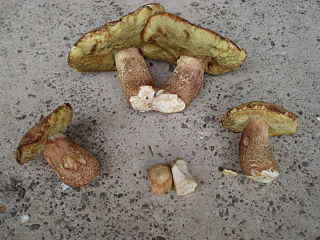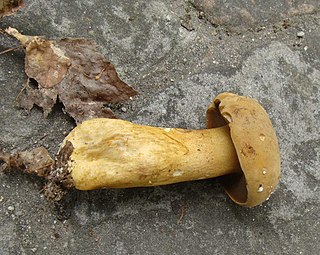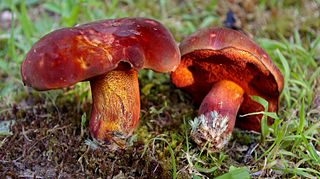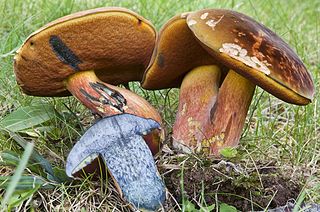
Rubroboletus pulcherrimus—known as Boletus pulcherrimus until 2015—is a species of mushroom in the family Boletaceae. It is a large bolete from Western North America with distinguishing features that include a netted surface on the stem, a red to brown cap and stem color, and red pores that stain blue upon injury. Until 2005 this was the only bolete that has been implicated in the death of someone consuming it; a couple developed gastrointestinal symptoms in 1994 after eating this fungus with the husband succumbing. Autopsy revealed infarction of the midgut.

Boletus barrowsii, also known in English as the white king bolete after its pale colored cap, is an edible and highly regarded fungus in the genus Boletus that inhabits western North America. Found under ponderosa pine and live oak in autumn, it was considered a color variant of the similarly edible B. edulis for many years.

Caloboletus rubripes, commonly known as the red-stipe bolete or the red-stemmed bitter bolete, is a mushroom in the family Boletaceae. It was known as Boletus rubripes until 2014. Fruit bodies (mushrooms) are robust, with caps up to 18 cm in diameter, atop thick stipes 5–12 cm long. Mushrooms are non-toxic, but is so bitter as to be inedible. The mushroom flesh has a very strong bluing reaction when cut or damaged. and forms mycorrhizal relationships, primarily with conifers. It can be differentiated from similar boletes by its cap color and non-reticulate stipe.

Boletus subcaerulescens is a basidiomycete fungus of the genus Boletus found in northeastern North America. The fruiting bodies are found associated with pine and spruce. The cap is up to 18 cm wide, convex to flat, and brown in color. The tubes are yellow and stain blue when bruised, while the flesh is white to buff and does not stain when cut. The stem is brown like the cap and has a light-colored reticulate texture.

Tylopilus tabacinus is a species of bolete fungus in the family Boletaceae. It is characterized by a tawny-brown cap measuring up to 17.5 cm (6.9 in) in diameter, and a reticulated stem up to 16.5 cm (6.5 in) long by 6 cm (2.4 in) thick. A characteristic microscopic feature is the distinctive crystalline substance encrusted on the hyphae in the surface of the cap. The species is known from the eastern United States from Florida north to Rhode Island, and west to Mississippi, and from eastern Mexico. It is a mycorrhizal species, and associates with oak and beech trees.

Boletus rubroflammeus is a species of bolete fungus in the family Boletaceae. First described from Michigan in 1971, it is found in the eastern United States and Mexico, where it grows in a mycorrhizal association with hardwood trees. The fruit bodies (mushrooms) of the fungus have caps that are deep red to purplish red, and dark red pores. The stem has coarse, dark red reticulations and a narrow yellow area at the top. All parts of the mushroom quickly stain blue when injured or cut. Lookalikes include Boletus flammans, a lighter-colored species that grows with conifers. Other similar species can be distinguished by differences in distribution, morphology, staining reaction, and microscopic characteristics. Boletus rubroflammeus mushrooms are poisonous, and can cause gastrointestinal distress if consumed.

Boletus subvelutipes, commonly known as the red-mouth bolete, is a bolete fungus in the family Boletaceae. It is found in Asia and North America, where it fruits on the ground in a mycorrhizal association with both deciduous and coniferous trees. Its fruit bodies (mushrooms) have a brown to reddish-brown cap, bright yellow cap flesh, and a stem covered by furfuraceous to punctate ornamentation and dark red hairs at the base. Its flesh instantly stains blue when cut, but slowly fades to white. The fruit bodies are poisonous, and produce symptoms of gastrointestinal distress if consumed.
Boletus vinaceobasis is a species of bolete fungus in the family Boletaceae. Found in North America, it was described as new to science in 1971 by Alexander H. Smith and Harry Delbert Thiers.

Tylopilus badiceps is a bolete fungus in the family Boletaceae native to North America. It was described in 1900 as Boletus badiceps by Charles Horton Peck, and transferred to the genus Tylopilus in 1971 by Alexander H. Smith and Harry Delbert Thiers. It is a good edible mushroom.

Boletus variipes is a species of mycorrhizal bolete fungus in the family Boletaceae, native to North America. It was originally described by American mycologist Charles Horton Peck in 1888.

Chalciporus pseudorubinellus is a bolete fungus of the family Boletaceae. It is found in North America and Central America.

Lanmaoa carminipes is a fungus of the family Boletaceae native to the United States. First described officially in 1971 by mycologists Alexander H. Smith and Harry Delbert Thiers as a species of Boletus, it was transferred to the newly circumscribed genus Lanmaoa in 2015.

Boletus bicoloroides is a fungus of the genus Boletus native to the United States. It was first described officially in 1971 by mycologists Alexander H. Smith and Harry Delbert Thiers.
Boletus fagicola is a fungus of the genus Boletus native to the United States. It was first described officially in 1971 by mycologists Alexander H. Smith and Harry Delbert Thiers.

Hemileccinum hortonii is a fungus of the genus Hemileccinum native to the United States. First described as variety corrugis of Boletus subglabripes by Charles Horton Peck in 1897, it was given its current name in 1971 by mycologists Alexander H. Smith and Harry Delbert Thiers. The species is edible.

Boletus subluridellus is a species of bolete fungus in the family Boletaceae. Described as new to science in 1971 by American mycologists, the bolete is found in the eastern United States and Canada. It grows on the ground in coniferous and mixed forests in a mycorrhizal association with deciduous trees, especially oak. The fruit bodies (mushrooms) have orangish-red, broadly convex caps that are up to 10 cm (3.9 in) in diameter, with small, dark reddish pores on the underside. The pale yellow stipe measures 4–9 cm (1.6–3.5 in) long by 1.5–2.3 cm (0.6–0.9 in) thick. All parts of the fruit body will quickly stain blue when injured or touched.
Leccinum broughii is a species of bolete fungus in the family Boletaceae. Found in the United States, it was described as new to science in 1971 by mycologist Alexander H. Smith and Harry Delbert Thiers.

Leccinum areolatum is a species of bolete fungus in the family Boletaceae. Found in the United States, it was described as new to science in 1971 by mycologists Alexander H. Smith and Harry Delbert Thiers. Josef Šutara proposed a transfer to Krombholziella in 1982.
Kenneth A. Harrison was a Canadian mycologist. He was for many years a plant pathologist at what is now the Atlantic Food and Horticulture Research Centre in Nova Scotia. After retirement, he contributed to the taxonomy of the Agaricomycotina, particularly the tooth fungi of the families Hydnaceae and Bankeraceae, in which he described several new species.

Boletus vermiculosoides is a species of bolete fungus in the family Boletaceae. Found in North America, it was described as new to science in 1971 by mycologists Alexander H. Smith and Harry Delbert Thiers. The type collection was made by Smith in Hartland, Michigan, in 1966.
















